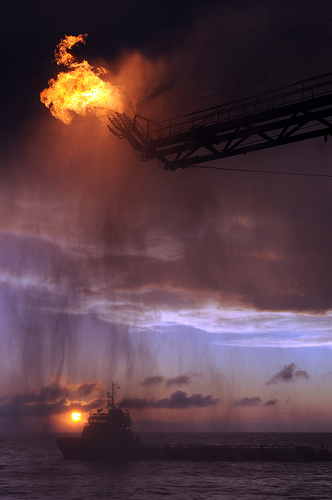On top of the massive amounts of oil being released into the Gulf as a result of the Deepwater Horizon disaster, a new and less known threat has emerged. According to seismic data huge pools of methane gas are located below the damaged oil well known as "Macondo." The US Geological Survey estimates that "2,900 cubic feet of natural gas…is being released into the Gulf waters with every barrel of oil."
Previous documentation of the subterranean geological formation below the Macondo well contained knowledge of the presence of this huge methane deposit. Despite the warnings that oil drilling would be problematic with a higher risk of a blow out due to the large deposit of methane, business went on as usual. But, some geologists estimate that the methane could be a massive bubble trapped for thousands of years waiting for release. Furthermore, the Macondo well has a 35% higher containment of methane
than other oil deposits, which added with hydrogen sulfide, benzene, and
oil are quickly depleting oxygen in water, suffocating marine life and
creating "dead zones," and causing a ripple effect through the ecosystem
down to small microbe life.
The pressure from the blown oil well is estimated between 30,000-70,000 pounds per square inch (psi), and it is speculated that the methane under the ocean floor may be as high as 100,000 psi, which far surpasses current technological ability for containment. The first signs of the methane burst are becoming apparent with the new presence of fissures and cracks that are appearing on the ocean floor. The proximity of these new fissures with that of already naturally occurring fault areas can prove devastating if the pressure from the methane deposit continues to build. The escape of such a large methane bubble will create a gas explosion, rupturing the seabed upwards propelling 50,000 psi of pressure with a single extreme explosion.
Such an underwater explosion can have several disastrous consequences. First it can cause the loss of buoyancy, which can cause oil structures and ships in the vicinity to sink due to the rapid change in buoyancy. Secondly, the event can set off a tsunami traveling at high speeds to Florida, and the other gulf states like Texas, Louisiana, Mississippi, Alabama, and the southern region of Georgia. Finally, after the release of billions of barrels and cubic feet of oil and gas, the massive cavity beneath the seabed will begin to normalize allowing freezing water to be forced into the vacant space, which normally is at an extremely hot temperature around 150 degrees celsius. This clash in temperature will vaporize the water and turn it into steam creating another pressure cooker which could lift the Gulf floor a second time creating another massive tsunami.
Image: "Deepwater Horizon Flaring Operation" on Flickr courtesy of
Creative Commons Licensing.















